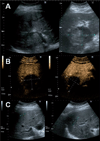Multiple liver abscesses with isolation of Streptococcus intermedius related to a pyogenic dental infection in an immuno-competent patient
- PMID: 20696645
- PMCID: PMC3351958
- DOI: 10.1186/2047-783x-15-7-319
Multiple liver abscesses with isolation of Streptococcus intermedius related to a pyogenic dental infection in an immuno-competent patient
Abstract
Introduction: Streptococcus intermedius - a member of the Streptococcus anginosus group - is part of the normal microbial flora of the oral cavity. Despite being regarded as a harmless apathogenic commensal, Streptococcus intermedius has been described to cause abscesses in various locations of the body.
Case presentation: We report the clinical case and course of treatment of a 18-year-old male patient presenting with multiple hepatic abscesses associated with an untreated pyogenic dental infection.
Conclusion: Streptococcus intermedius can cause liver abscesses emerging from dental infectious foci even in previously healthy patients without underlying innate or aquired immunodeficiency. The case illustrates the potential danger and underestimated risk associated with untreated dental infections.
Figures





Similar articles
-
Multiple liver abscesses caused by S treptococcus intermedius bacteremia in the setting of a routine dental cleaning.BMJ Case Rep. 2020 Feb 28;13(2):e233097. doi: 10.1136/bcr-2019-233097. BMJ Case Rep. 2020. PMID: 32111710 Free PMC article.
-
Electronic clinical challenges and images in GI. Pyogenic liver abscesses caused by an infection with Streptococcus intermedius (Streptococcus milleri group).Gastroenterology. 2008 Dec;135(6):e3-4. doi: 10.1053/j.gastro.2008.10.071. Epub 2008 Nov 8. Gastroenterology. 2008. PMID: 19000680 No abstract available.
-
Case 5: Right Upper Quadrant Abdominal Pain in an Otherwise Healthy 8-year-old Girl.Pediatr Rev. 2017 Apr;38(4):187-188. doi: 10.1542/pir.2015-0178. Pediatr Rev. 2017. PMID: 28364053 No abstract available.
-
[Detection of early gastric cancer facilitated by surveillance for a pyogenic liver abscess caused by Streptococcus intermedius].Nihon Shokakibyo Gakkai Zasshi. 2016;113(2):263-72. doi: 10.11405/nisshoshi.113.263. Nihon Shokakibyo Gakkai Zasshi. 2016. PMID: 26853986 Review. Japanese.
-
Streptococcus intermedius causing infective endocarditis and abscesses: a report of three cases and review of the literature.BMC Infect Dis. 2008 Nov 10;8:154. doi: 10.1186/1471-2334-8-154. BMC Infect Dis. 2008. PMID: 18992173 Free PMC article. Review.
Cited by
-
Maxillary Teeth Abscesses Result in Atypical Liver Abscesses.Cureus. 2018 Mar 20;10(3):e2353. doi: 10.7759/cureus.2353. Cureus. 2018. PMID: 29796365 Free PMC article.
-
Streptococcus anginosus and Phalangeal Osteomyelitis: An Unusual Presentation.J Orthop Case Rep. 2020 Dec;10(9):19-22. doi: 10.13107/jocr.2020.v10.i09.1888. J Orthop Case Rep. 2020. PMID: 34169011 Free PMC article.
-
Misidentified Metastases: Diagnosing and Managing Pyogenic Liver Abscesses in a Breast Cancer Survivor.Am J Case Rep. 2024 Sep 27;25:e944117. doi: 10.12659/AJCR.944117. Am J Case Rep. 2024. PMID: 39327719 Free PMC article.
-
Multiple liver abscesses caused by S treptococcus intermedius bacteremia in the setting of a routine dental cleaning.BMJ Case Rep. 2020 Feb 28;13(2):e233097. doi: 10.1136/bcr-2019-233097. BMJ Case Rep. 2020. PMID: 32111710 Free PMC article.
-
Invasive Streptococcus intermedius Infections in Children: Two Cases from a Pediatric Infectious Diseases Unit in Italy.Pathogens. 2024 Dec 12;13(12):1099. doi: 10.3390/pathogens13121099. Pathogens. 2024. PMID: 39770358 Free PMC article.
References
-
- Mirzanejad Y, Stratton CW. In: Principles and practice of infectious diseases. Philadelphia: Elsevier Churchill Livingstone. Mandell GL, Bennett JE, Dolin R, editor. 2005. Streptococcus anginosus Group; pp. 2451–2455.
Publication types
MeSH terms
LinkOut - more resources
Full Text Sources
Medical

